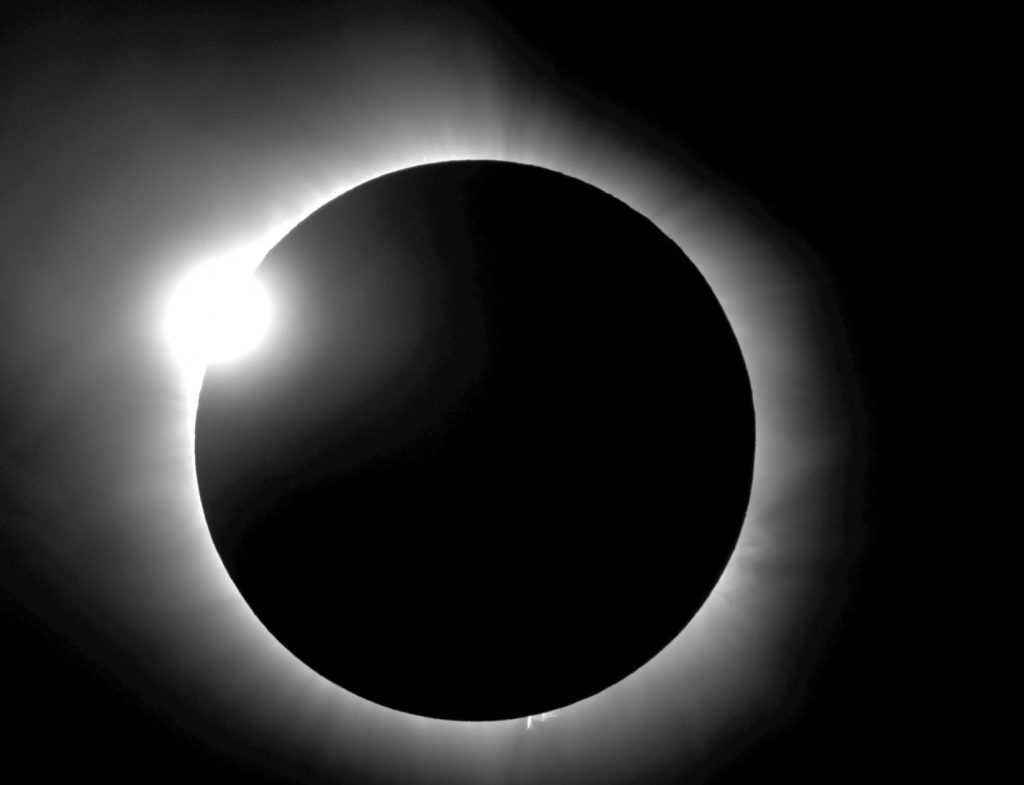POTTSTOWN — As a significant cosmic event approaches, those planning to look at the sky got a glimpse of what to expect from a NASA expert during a recent event at the Pottstown Regional Public Library.
Donald R. Miller, a NASA Solar System Ambassador, was present on March 26 to talk about the details of eclipses and the upcoming total solar eclipse in particular.
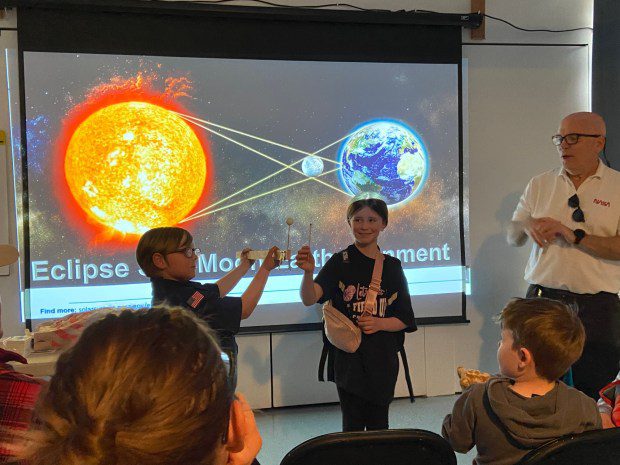
On Monday, April 8, a total solar eclipse of the sun will pass over Mexico, the United States, and Canada. A total solar eclipse occurs when the moon moves between the sun and Earth, completely covering the sun. The sky will darken as if it were dawn or dusk.
Following April 8, the next total solar eclipse visible in the United States will not happen again until Aug. 23, 2044.
Due to our location in Southeast Pennsylvania, only about 90 percent of the sun will be covered.
Miller, who resides in Chester County, mentioned that he will travel to Erie to observe the eclipse where the sun will be 100 percent obstructed.
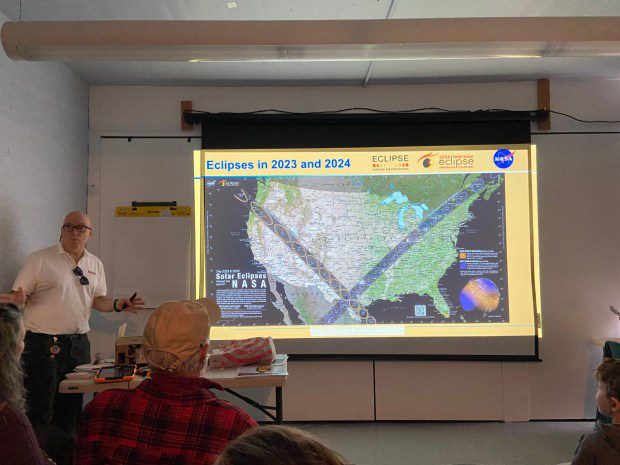
The path of darkness, known as “the totality,” will be 150 to 200 miles wide and will move across the Earth at speeds of 2,000 to 2,500 miles per hour, which is why the totality will only last 4 minutes and 28 seconds in any one place, according to NASA.
However, those 4 minutes can be “a life-changing experience, it was for me,” Miller informed the crowd.
A member of the audience shared her experience during a total eclipse. She mentioned that it was cloudy where they were, but they could see the sun in the distance so they hurried toward it. “We ended up watching it in the middle of a farm field. It goes dark, but it also gets very quiet. All the stars come out, and then as the light returns, all the birds start singing again and you can hear the insects start buzzing again.”
The entire event lasts longer than 4 minutes, that’s only “the totality.” In this area, the first effects will be visible at 2:08 p.m. and will reach maximum visual impact at 3:23 p.m., according to Miller. The last visual effects will end at 4:35 p.m.
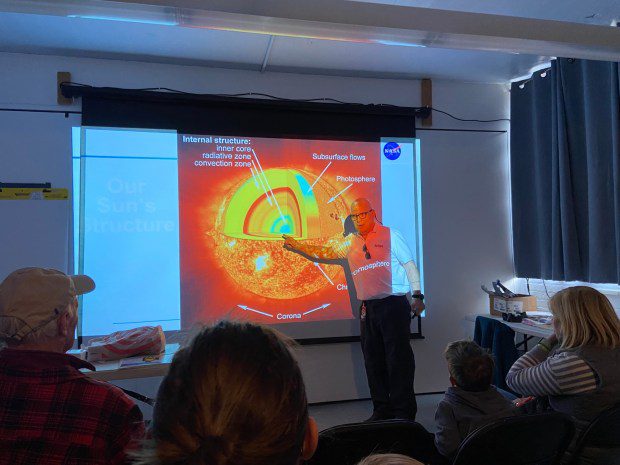
Miller reminded the group that the sunlight peeping around the moon during the eclipse will be old light, 8 minutes old to be exact, because that is how long it takes the light from the sun, traveling at 186,000 miles per second, to reach the Earth, 92.8 million miles away.
There are also specific effects to watch out for including “Bailey’s beads,” caused by the sun’s rays passing through the valleys but being blocked by the peaks on the moon; the “diamond ring effect,” when the sun starts to peek around the edge of the moon while maintaining a corona around the moon’s circumference; and the “Purkinje effect,” which occurs five minutes before the totality when color shifts toward blue, making red, yellow and orange appear flat.
Miller stressed that the light from the eclipse can be just as dangerous as it is life-giving. NASA is prioritizing safety for those who want to directly observe the eclipse.
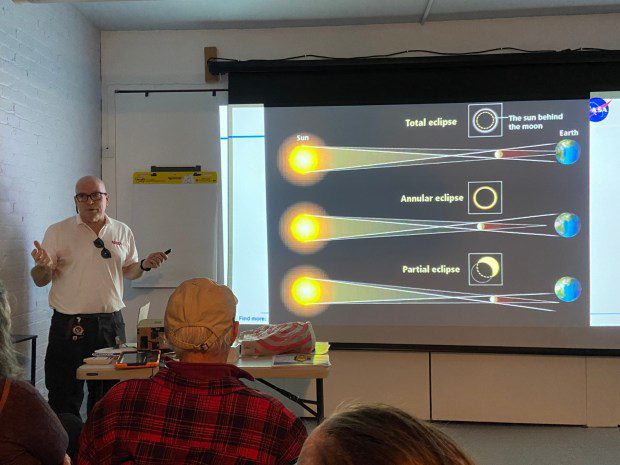
Special foil goggles were given out at the event and are available at Lowe’s in North Coventry, Wal-Mart in Pottstown, or America’s Best Contacts on Shoemaker Road in Pottstown. Make sure they are labeled to meet the ISO-12312-2 standard, as recommended by Miller.
He emphasized that the lenses should not be touched, and the glasses should be discarded if they have scratches or holes. He also cautioned that regular sunglasses are not adequate for protecting your eyes during an eclipse.
He shared a story about a woman who experienced eye problems after repeatedly putting on and taking off her goggles during an eclipse. The next day, she visited an ophthalmologist and had the image of the eclipse “burned onto her retina. So it’s important that you take this seriously.”
One safe and affordable way to observe an eclipse is indirectly, he mentioned. Instructions for building a “pinhole camera” can be found on NASA’s website. by using nothing more than a cardboard box and some paper.
For those interested in viewing the eclipse with others, the Chester County Astronomical Society will host a live viewing at Hibernia Park’s pavilion 5 in Coatesville, from 2 to 4:30 p.m. on April 8, with special solar telescopes available for safe direct viewing.
Of course, eclipse viewers must also be prepared for the possibility of cloudy conditions on the day of the eclipse. “You’ll just see the sky darken” is about all that will be visible, according to Miller.
However, there are numerous options for watching the eclipse live online. Two excellent websites are NASA’s own and the one for the “Exploratorium” science museum in San Francisco, founded by Robert Oppenheimer, which Miller described as “the best hands-on science museum I have ever been to, and I’ve been to a lot.”





